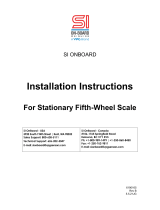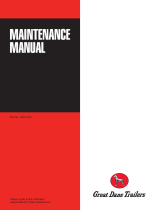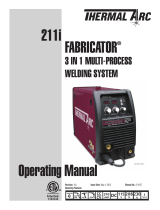Page is loading ...

SI ONBOARD
Installation Instructions
For Sliding Fifth-Wheel Scale
6190164
Rev B
5.5.21JG
SI OnBoard - USA
5920 South 194th Street | Kent, WA 98032
Sales Support: 800-638-5111
Technical Support: 626-202-5047
E-mail: sionboard@vpgsensors.com
SI OnBoard - Canada
#106-1765 Springfield Road
Kelowna, BC V1Y 5V5
Ph: +1-800-989-1499
|
+1-250-860-8450
Fax: +1-250-762-9811
E-mail: sionboard@vpgsensors.com

Table Of Contents
Introduction
1
Fifth Wheel Preparation
2
Fifth Wheel/Load Cell Assembly
3
Sliding Fifth Wheel Re-assembly
4
Welding Procedure
6
Bolt Torque Value
8
Cable Installation
9
Routine Maintenance
9
Installation Checklist
10

1
Introduction
The SI on-board fifth wheel scale is highly advanced electronic measuring device.
Weight is “sensed” by two load cells that are mounted between the tractor frame and
fifth wheel. These rugged load cells are strong enough to provide years of reliable
service, yet are sensitive enough to detect a change in weight of just a few pounds.
SI scales are available for most popular fifth wheels. Due to differences between the
models, there may be minor assembly variations. The installation process is virtually the
same whether it is being performed as a retrofit or to a new vehicle.
It is extremely important to follow these installation guidelines and use the specified
materials to ensure that completed assembly will maintain it high strength and maximum
safety. It will also result in minimum installation costs, high accuracy and long life for
your scale system.
Warning:
Failure to follow these instructions could cause a hazardous operating condition.
Upon completion of the load cell installation, you will need to install the SI 9100 digital
meter, transmitter and cabling. You also need to calibrate the scale system. Complete
instructions for these procedures can be found in the operator’s manual included with
your SI 9100 digital meter.
Warning:
Installation must be in accordance with regulations of the U.S. Department of
Transportation, State and local regulations, SAE recommended practices and
standard, and tractor and trailer manufacturer’s specifications.
International users: Installation must be in accordance with the regulations of
city, state, province and country, as they may apply to installations outside of the
USA.
An installation checklist has been provided on page 10 of this manual. Refer to it during
installation and check off the important steps as they are completed

2
Fifth Wheel Preparation
Begin the scale installation by removing the stop plates located at the rear of the Slider
base (the stop plates may already be loose if the installation is on a new Slider).
Figure 1
Separate the fifth wheel plate/support bracket assembly from the base by sliding it off
toward the rear (see Figure 1). Pull the pivot pins and disassemble the fifth wheel plate
from the support brackets. Set the support brackets aside for later use.
Notes:
All fifth wheels must be thoroughly cleaned and inspected for damage prior to
installation the fifth wheel load cells. DO NOT use faulty components in the fifth wheel
installation.

3
Fifth Wheel/Load Cell Assembly
The load cells are shipped with support brackets and fifth wheel trunnion already
attached. Attach the load cell/trunnion assemblies to the fifth wheel plate by using the
pivot pins (see Figure 2).
Notes:
Load cells should be attached to the fifth wheel so that the cable connectors are faced
inward for maximum protection.
Figure 2
Reinstall the fifth wheel (with the load cell assembly attached) into the Holland Base.
Note:
Weight distribution on the tractor axles is dependent upon the position of the fifth wheel.
The indicator will need to be re-calibrate each time the fifth wheel is positioned to ensure
the accurate weight measurement.

4
Sliding Fifth Wheel Re-assembly
With the fifth wheel/load cell assembly in place on the Sliding base, re-assembly the
locking mechanism.
Note:
SI Sliding fifth wheel brackets were designed to be directly interchangeable with the new
design of the slider bracket and locking plunger. Shown in Figure 3 are the old and new
style locking plungers.
Figure 3
Carefully remove the reinforcing plates welded between the old Slider brackets using a
low hydrogen process and E70XX filler metal (see Figure 4).
Figure 4
Check the freedom of movement of the slider brackets and proper operation of the
release mechanism.

5
Slide the fifth wheel to it’s rearmost position. Locate the rear slide stops so that 1/8” to
¼” space is provided between slider brackets and stop. Weld stop securely to base
plate. Weld in the location shown in Figure 5 and ensure that the weld does not interfere
with the slider operation.
Figure 5

6
Welding procedure
The procedure has been prepared to guide the welder on the proper method for welding
bearing plates to frame mounting members.
Warning:
All welding, metal working, and assembly must be performed by a qualified
person using proper tools and safe work habits. When welding, use a procedure
which assure a sound, good quality weld. Over-welding may cause distortion and
damage; under-welding may not develop sufficient strength.
Caution:
Take precautions to ensure that the vehicle electrical system is not damaged by
welding. Attach ground strap directly to vehicle frame when welding to prevent
electrical current flow through load cells.
Welding Process:
Use a low hydrogen process and AWS E7018 rod or equivalent. The bearing plate may
be welded using SMAW stick, GMAW spray transfer, or FCAW. The user should not
use GMAW short circuit transfer.
Welding Configuration:
The bearing blocks should be attached using a multi-pass fillet weld sequence as shown
in Figure 6.
Deposited Weld Metal Fillet Sizes:
The finish multi-pass fillet assembly should be a minimum of ½” (13mm) as shown in
Figure 6.
Fillet Metal:
The electrode should be in Table 1:
Electrode specification:
Process
Size
Type
Comment
SMAW
1/8. 5/32, or 3/16
E7018
Must be dry
FCAW
.045 to 3/32
E71T-5 or E70T-5
Gas shielded
GMAW
.035 to 1/16
E70S-6
Spray transfer
Table 1

7
Figure 6
Preheat:
The bearing blocks and frame mounting surface should be warmed in preparation for
welding to reduce shrinkage stress. Any suitable torch arrangement is satisfactory.
Spot heating should be avoided. The preheat temperature should be a minimum of
70° F and a maximum of 150° F.
Cleaning Before Welding:
The bearing plates will come to customer ready for welding. Edges of the bearing plates
should be visually inspected to verify that there is no oil, grease, dirt, paint or other
foreign substance that will reduce the weld quality. The mounting angles should be
surface ground or power wire brushed so as to remove all paint, primer, or other surface
coating. An area the size of the bearing block plus one inch needs to be cleaned and
grounded to bare base metal.
In Process Cleaning:
Each fillet bead should be visually inspected with all slag cover removed, before
proceeding with next bead. A stiff wire brush or needle scalar may be used for slag
removal.

8
Final Inspection:
Long service life depends on quality application of the fillet welds and THE FINAL SIZE
OF THE FILLETS. There shall be no undercut on either the upper leg (bearing plate) or
the lower leg (frame base metal). Any undercut shall be repaired with an additional fillet
or continued by grinding to remove the mechanical notch. Visually inspect all weld stops
and starts. Weld craters should be filled. All weld stops shall be staggered. A light coat
of primer and paint may be applied after final inspection.
Periodic inspection:
These primary load carrying fillet welds should be inspected during routine maintenance.
Warning:
Heat from welding may loosen bolts. Therefore, all torque values should be
rechecked after installation when all welds have cooled.
Bolt Torque Value
Torque value can vary significantly depending upon the lubricating of the threads. The
following values are based upon new, clean threads. SI recommends the use of a
thread lubricant such as Locktite 767 or equivalent, to prevent the seizing of threads
over long period of time. These torque values can be used for bolts with this lubricant,
without over-stressing bolts.
All bolts are to be SAE Grade 8, all lock nuts Grade C. Use only new bolts and lock nuts.
Application
Fastener Size
Torque Value
Frame Mount
5/8”-18 UNF
225 ~ 250 ft•lb
Load Cell Mount
1 ¼” -12 UNF
1000 ft•lb
Trunnion Mount
¾” -16 UNF
380 ~ 420 ft•lb
Table 2

9
Cable Installation
SI cables are specially designed to provide maximum single strength and high reliability.
Substitution of cabling other than SI supplied cabling may cause inconsistent and erratic
readings. Care should be taken when routing the cables, to provide protection from the
sharp edges, exhaust pipe or any other potential damage (see Figure 7). Secure in
place with cable ties to a snug fit.
Figure 7
Connect the cable connector to the load cells. Assembly of the cable connector to the
load cell should not be forced. Align the “Keyways” and insert the cable connector into
the load cell. As the cable connector is being inserted, rotate the threaded sleeve
clockwise until hand tight. Ensure the connector has been fully inserted for maximum
moisture protection by wriggling the connector and re-tightening the sleeve.
Routine Maintenance
Listed below are four simple steps that should be periodically performed to ensure
safety, and to maintain your scale system in top operating condition.
1. Inspect all welds for signs of cracking or corrosion.
2. Retighten all fasteners to specified torque values.
3. Inspect cables and connectors for damage and tightness.
4. Clean truck/trailer connection.

10
Installation Checklist
Fifth wheel has been cleaned and inspected for damage.
Mounting angles have been inspected for burrs, inconsistencies, and tureens.
Truck frames have been inspected and are in good condition.
Surfaces for load cell bearing plates are rigid or have been reinforced.
All welds “triple pass or equivalent” (See welding procedure)
All bolts are torqued to the specifications.
All connectors properly inserted tight and facing in-board.
All cables routed and secured in protected areas of the frame.
Indicator installation per meter user’s manual.
System Calibration: See meter user’s manual.
Troubleshooting: See meter user’s manual.
/






